Elementary Music Theory
by Reed W. Robins
PART 1 ACOUSTICS and PROPERTIES OF SOUND
Sound is Produced by Vibration With a Guitar, for example: THE VIBRATING STRING(vibrates) THE AIR(vibrates)THE EARDRUM the vibration of the eardrum produces the sensation of sound Noise is the result of irregular vibration patterns Tones are the result of regular vibrations Tones have 4 basic characteristics Pitch: high or low Duration: length of the sound Intensity: volume or loudness Timbre: "color" of the sound Let's examine further the action of a plucked string (the principle is, of course, the same for a vibrating column of air, or a vibrating membrane, etc.):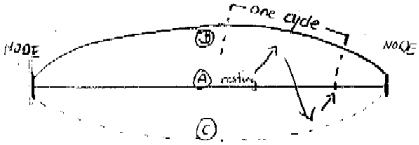 When you pluck the string from it's resting point (a) it goes up to (b), back past (a) to
(c), and then back to (a), it has completed one cycle.
Nodes are points of no pratical vibration (in this case, at each end of the string).
The greater the distance between (b) and (c), the louder the tone-in other words-wide
vibration = loud tone/narrow vibration = soft tone.
The Number of cycles per second (hertz-abbreviated Hz.) is the frequency of the tone.
the A a 3rd below middle C is 440 Hz. (440 cycles per second)
When you pluck the string from it's resting point (a) it goes up to (b), back past (a) to
(c), and then back to (a), it has completed one cycle.
Nodes are points of no pratical vibration (in this case, at each end of the string).
The greater the distance between (b) and (c), the louder the tone-in other words-wide
vibration = loud tone/narrow vibration = soft tone.
The Number of cycles per second (hertz-abbreviated Hz.) is the frequency of the tone.
the A a 3rd below middle C is 440 Hz. (440 cycles per second)
OVERTONES:
One aspect we have yet to discuss about the properties of a tone is it's overtones-just as white light is made up many different colors of the "spectrum" (ever seen sunlight through a prism?) The "spectrum" of a tone is it's overtone series. You see the string we just talked about also has vibrations other than the fundamental vibration we've already spoken of. It also vibrates: In Halfs In Thirds
In Thirds
 In Quarters
In Quarters
 Etc.
Each of these produces a pitch called an overtone or partial which is heard (although
less loudly) along with the fundamental pitch. These together produce a composite
sound which give a particular instrument its characteristic sound.
Etc.
Each of these produces a pitch called an overtone or partial which is heard (although
less loudly) along with the fundamental pitch. These together produce a composite
sound which give a particular instrument its characteristic sound.
 So, for a low C on a typical soundmaking device the overtone series would look like
this:
So, for a low C on a typical soundmaking device the overtone series would look like
this:
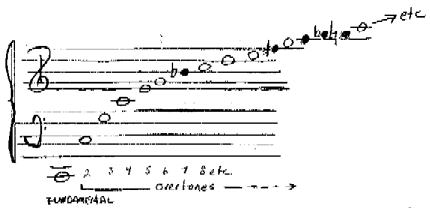 Some observations about the properties of overtones:
In general, the lower the partial the louder it is- the fundamental is loudest-higher
overtones are fainter in volume
the overtone series continues on up in finitum
The spacing of the overtone series is widest at the bottom, becoming gradually
narrower as it goes higher in range
the mix of the particular overtones is the principle determiner of the sound quality or
"color" of a musical instrument*
* (for instance, one might find in a sonic laboratory the human vocal sound is highly
rich in overtones, or the oboe's sound tends to emphasize odd number partials, or the
sound of a woodblock tends to be lacking in midrange overtones)
-Being fully aware of the scope of this topic can greatly enhance writing and arranging
abilities-for example the same chord will have quite a different effect if arranged for
4 vocalists instead of 4 trumpets.
A Word About Pythagoras:
For musicians Pythagoras's name should have a great deal more significance than that painful
memory of 2nd semester high school geometry. Pythagoras made important discoveries about pitch,
discoveries that brought about both the development of our system of twelve tones and the
development of our understanding of the basic natural properties of sound.
Get Ready, Here it is in a nutshell:
The pitches sounded by a musical instrument are related to the length of the strings *
* (Keep in mind that while this doesn't sound like much now, this was quite the discovery in
the 6th century B.C.)
* (Also note that this is again the same principle with a column of air, streched membrane,
etc.-Pythagoraras, however; is said to have done the original experimentation with a string.)
You See, Pythagoras stretched a string of a given length across a sounding board-and
made the following discoveries:
When divided in half (ratio of 2:1)-An octave above the string's original pitch was
produced
When divided in thirds (ratio of 3/2:1)-A fifth above the string's original pitch was
produced
When divided in quarters (ratio of 5/4:1)-A third above the string's original pitch was
produced
Continuing in this manner the entire overtone series was eventually produced. and the
first 16 partials were used to devise a scale *
* (This produced the first system of tuning. Ancient music tended to seldom modulate
and was in a small range. Common beliefs hold that the use of wider ranges, contrupuntal
textures and modulation in music are fairly new devices in the total history of music
(although the earliest music is scantily documented). If the piano in your 20th century
living room was tuned this way, however; the lowest and highest C's would sound out of
tune with one another (the highest sounding flat in relation to the lowest). This phenomenon
is called the pythagorean comma, and occurs in the tuning system that is derived in nature
through the aformentioned method. Twenty centuries of calculations have produced a system
in the western world which solves this problem by dividing the octave into twelve equal
parts. This system is called Equal Temperment Tuning. it's precursor (Well Temperment
tuning) was in common use by the time of Bach. This system of tuning, which allowed for
free chromaticism and modulation, was the inspiration of Bach's Well Tempered Clavier,
which is a book of preludes and Fugues in all 24 Keys -major and minor.) for a look at the
many types of tuning systems used throughout history (many of which can be dialed up for
interesting effect on your synth), look up "Tuning systems" in the Harvard Dictionary of Music.
As you will see in the course of this study, these notes are not only the the first partials
of the overtone series of any given note, but also the notes which comprise the most
basic of all chords, the major triad. This is profound evidence of the effect of the
natural laws of sonics and thier relationship with the development of harmony in music
in cultures all over the world.
Here's how they are arranged on the keyboard:
Some observations about the properties of overtones:
In general, the lower the partial the louder it is- the fundamental is loudest-higher
overtones are fainter in volume
the overtone series continues on up in finitum
The spacing of the overtone series is widest at the bottom, becoming gradually
narrower as it goes higher in range
the mix of the particular overtones is the principle determiner of the sound quality or
"color" of a musical instrument*
* (for instance, one might find in a sonic laboratory the human vocal sound is highly
rich in overtones, or the oboe's sound tends to emphasize odd number partials, or the
sound of a woodblock tends to be lacking in midrange overtones)
-Being fully aware of the scope of this topic can greatly enhance writing and arranging
abilities-for example the same chord will have quite a different effect if arranged for
4 vocalists instead of 4 trumpets.
A Word About Pythagoras:
For musicians Pythagoras's name should have a great deal more significance than that painful
memory of 2nd semester high school geometry. Pythagoras made important discoveries about pitch,
discoveries that brought about both the development of our system of twelve tones and the
development of our understanding of the basic natural properties of sound.
Get Ready, Here it is in a nutshell:
The pitches sounded by a musical instrument are related to the length of the strings *
* (Keep in mind that while this doesn't sound like much now, this was quite the discovery in
the 6th century B.C.)
* (Also note that this is again the same principle with a column of air, streched membrane,
etc.-Pythagoraras, however; is said to have done the original experimentation with a string.)
You See, Pythagoras stretched a string of a given length across a sounding board-and
made the following discoveries:
When divided in half (ratio of 2:1)-An octave above the string's original pitch was
produced
When divided in thirds (ratio of 3/2:1)-A fifth above the string's original pitch was
produced
When divided in quarters (ratio of 5/4:1)-A third above the string's original pitch was
produced
Continuing in this manner the entire overtone series was eventually produced. and the
first 16 partials were used to devise a scale *
* (This produced the first system of tuning. Ancient music tended to seldom modulate
and was in a small range. Common beliefs hold that the use of wider ranges, contrupuntal
textures and modulation in music are fairly new devices in the total history of music
(although the earliest music is scantily documented). If the piano in your 20th century
living room was tuned this way, however; the lowest and highest C's would sound out of
tune with one another (the highest sounding flat in relation to the lowest). This phenomenon
is called the pythagorean comma, and occurs in the tuning system that is derived in nature
through the aformentioned method. Twenty centuries of calculations have produced a system
in the western world which solves this problem by dividing the octave into twelve equal
parts. This system is called Equal Temperment Tuning. it's precursor (Well Temperment
tuning) was in common use by the time of Bach. This system of tuning, which allowed for
free chromaticism and modulation, was the inspiration of Bach's Well Tempered Clavier,
which is a book of preludes and Fugues in all 24 Keys -major and minor.) for a look at the
many types of tuning systems used throughout history (many of which can be dialed up for
interesting effect on your synth), look up "Tuning systems" in the Harvard Dictionary of Music.
As you will see in the course of this study, these notes are not only the the first partials
of the overtone series of any given note, but also the notes which comprise the most
basic of all chords, the major triad. This is profound evidence of the effect of the
natural laws of sonics and thier relationship with the development of harmony in music
in cultures all over the world.
Here's how they are arranged on the keyboard:
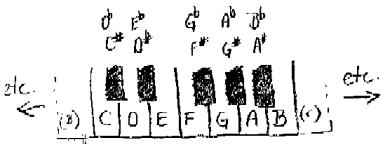 THE SOUND ENVELOPE:
The sound envelope is a visual representation of the contour of a sound.:
There are 4 ingredients of the basic sound envelope:
1) attack
2) sustain
3) decay
4) release
A typical envelope might look like this:
THE SOUND ENVELOPE:
The sound envelope is a visual representation of the contour of a sound.:
There are 4 ingredients of the basic sound envelope:
1) attack
2) sustain
3) decay
4) release
A typical envelope might look like this:
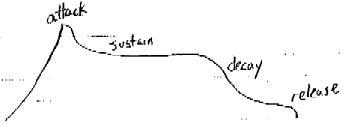 Almost all synthesizers today have envelope generators which give the musician
control over these parameters and allow shaping of a sound. Often they also have
several other parameters added to the envelope for even greater control over the
sound.
-being aware of the differing shapes of sound envelopes of different instruments can
also add to writing and arranging skills-
For example:
A woodblock's envelope might look like this:
Almost all synthesizers today have envelope generators which give the musician
control over these parameters and allow shaping of a sound. Often they also have
several other parameters added to the envelope for even greater control over the
sound.
-being aware of the differing shapes of sound envelopes of different instruments can
also add to writing and arranging skills-
For example:
A woodblock's envelope might look like this:
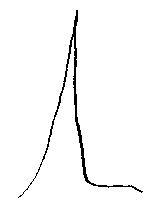 While a bowed violin might look like this:
While a bowed violin might look like this:
 or a guitar:
or a guitar:
 Keep in mind that the same instrument can have many different types of envelopes
depending on how it is played at any given moment (soft/loud, staccato/legato,
pizz./Arco, etc.)
Keep in mind that the same instrument can have many different types of envelopes
depending on how it is played at any given moment (soft/loud, staccato/legato,
pizz./Arco, etc.)
E-mail us with questions or comments. Updated 16-Jul-95.